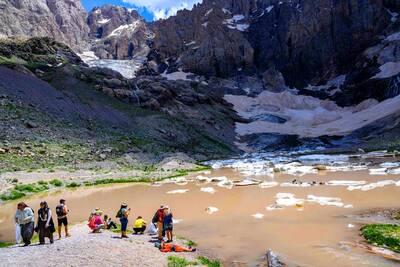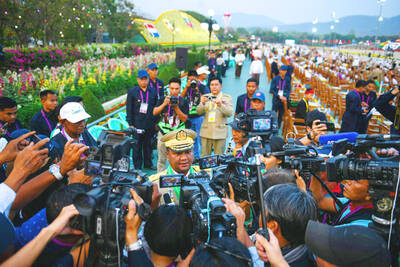Federal scientists testing for pharmaceuticals in water have been finding significantly more medicine residues in sewage downstream from public treatment facilities that handle waste from drugmakers.
Early results from two pivotal federal studies compare wastewater at treatment plants that handle sewage from drugmakers with those that do not. The studies cover just a small fraction of the 1,886 pharmaceutical manufacturing facilities counted in a 2006 US Census report.
In one study, samples taken at two treatment plants down the sewer line from drugmaking factories contained a range of pharmaceuticals — among them opiates, a barbiturate and a tranquilizer at “much higher detection frequencies and concentrations” than samples taken at other plants, a preliminary research by the US Geological Survey (USGS) showed.
One drug, the muscle relaxant metaxalone, was measured in treated sewage at concentrations hundreds of times higher than the level at which federal regulators can order a review of a drug’s environmental impact.
Based on secrecy agreements with the researchers, the treatment plants were not identified.
USGS researcher Herb Buxton, who co-chairs a White House task force on pharmaceuticals in the environment, said it’s important that federal scientists test the pharmaceutical industry’s claims that their wastewater is not a meaningful source of pharmaceuticals in water.
“It’s critical that those types of assumptions are confirmed through real testing,” Buxton said.
In another study, Environmental Protection Agency researchers tested sewage at a municipal wastewater treatment plant in Kalamazoo, Michigan, that serves a major Pfizer Inc factory.
Bruce Merchant, Kalamazoo’s public services director, provided data that showed unusually high concentrations of the antibiotic lincomycin entering the plant, a drug the factory was producing around the time samples were collected.
“There’s some product going down the drain,” Merchant said.
While nearly all the lincomycin was removed during wastewater treatment, some did survive. According to a separate study last year, lincomycin combined in minute concentrations with several other drugs that also have been detected in surface water made human cancer and kidney cells and fish liver cells proliferate.
Biologist Francesco Pomati at the University of New South Wales in Sydney, Australia, was so concerned with the findings that he and his colleagues warned that chronic exposure to the combination of drugs via drinking water could be “a potential hazard for particular human conditions, such as pregnancy or infancy.”
In earlier experiments, lincomycin acted as a mutagen, changing genetic information in bacteria, algae, microscopic aquatic animals and fish.
Pfizer spokesman Rick Chambers said that while the company does not test wastewater from the facility for the drugs made on site, “compliance with all environmental, health and safety laws is imperative to our business operations worldwide.”
The two domestic studies follow a burst of recent research in Asia and Europe that has started to link factories to the presence in water of drugs, including the antibiotic sulfamethoxazole, the pain reliever diclofenac and the anticonvulsant carbamazepine, as well as an antihistamine, female sex hormones and aspirin.
Researchers in India, where multinational companies have increasingly turned for the manufacture of raw pharmaceutical ingredients, found that 100 pounds (220kg) a day of the antibiotic ciprofloxacin enters a river from a wastewater treatment plant that processes sewage from dozens of pharmaceutical makers.
In Switzerland, a study sponsored by drugmaking giant Roche documented that 0.2 percent of active pharmaceutical ingredients escape during its own processing. That kind of loss rate doesn’t sound like a lot until it’s projected out over the entire annual production of drugs worldwide. Studies in Taiwan and China also suggest drugmaking plants discharge product.
All of which raises questions about US manufacturing.
“Is it as bad in the US as it is in India? Probably not. But it does make me think we should test,” said Kyla Bennett, a former EPA enforcement officer who is now an ecologist and environmental attorney.

In the sweltering streets of Jakarta, buskers carry towering, hollow puppets and pass around a bucket for donations. Now, they fear becoming outlaws. City authorities said they would crack down on use of the sacred ondel-ondel puppets, which can stand as tall as a truck, and they are drafting legislation to remove what they view as a street nuisance. Performances featuring the puppets — originally used by Jakarta’s Betawi people to ward off evil spirits — would be allowed only at set events. The ban could leave many ondel-ondel buskers in Jakarta jobless. “I am confused and anxious. I fear getting raided or even

Kemal Ozdemir looked up at the bare peaks of Mount Cilo in Turkey’s Kurdish majority southeast. “There were glaciers 10 years ago,” he recalled under a cloudless sky. A mountain guide for 15 years, Ozdemir then turned toward the torrent carrying dozens of blocks of ice below a slope covered with grass and rocks — a sign of glacier loss being exacerbated by global warming. “You can see that there are quite a few pieces of glacier in the water right now ... the reason why the waterfalls flow lushly actually shows us how fast the ice is melting,” he said.

RISING RACISM: A Japanese group called on China to assure safety in the country, while the Chinese embassy in Tokyo urged action against a ‘surge in xenophobia’ A Japanese woman living in China was attacked and injured by a man in a subway station in Suzhou, China, Japanese media said, hours after two Chinese men were seriously injured in violence in Tokyo. The attacks on Thursday raised concern about xenophobic sentiment in China and Japan that have been blamed for assaults in both countries. It was the third attack involving Japanese living in China since last year. In the two previous cases in China, Chinese authorities have insisted they were isolated incidents. Japanese broadcaster NHK did not identify the woman injured in Suzhou by name, but, citing the Japanese

RESTRUCTURE: Myanmar’s military has ended emergency rule and announced plans for elections in December, but critics said the move aims to entrench junta control Myanmar’s military government announced on Thursday that it was ending the state of emergency declared after it seized power in 2021 and would restructure administrative bodies to prepare for the new election at the end of the year. However, the polls planned for an unspecified date in December face serious obstacles, including a civil war raging over most of the country and pledges by opponents of the military rule to derail the election because they believe it can be neither free nor fair. Under the restructuring, Myanmar’s junta chief Min Aung Hlaing is giving up two posts, but would stay at the